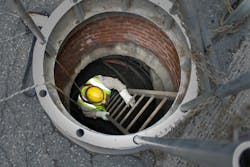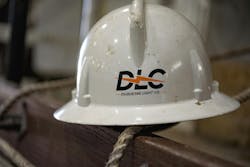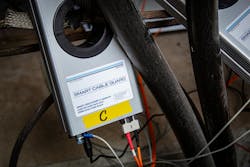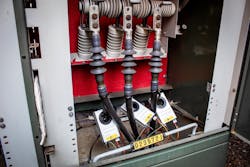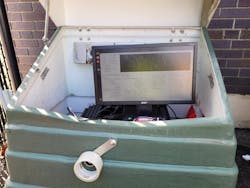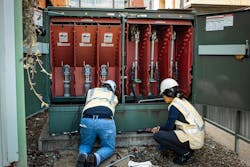Duquesne Light Company Crowdsources Underground Monitoring
As the electric utility serving the Pittsburgh, Pennsylvania, U.S., region, safety is and always has been Duquesne Light Company's top priority — both for its employees and customers. Because of the inherent danger of the work, the industry aims to continuously improve safety standards and best practices. One of the ways to improve is by using new methods, including open innovation.
Underground workers are responsible for maintaining the electric grid that runs underneath people’s feet and, by the nature of this environment, working conditions are often deep and restrictive. Because of this, underground workers undergo extensive training and education to certify they have the proper knowledge and skills to do the job safely and effectively. Even with proper training, resources and alertness, risks remain. In 2021, a Duquesne Light Company (DLC) worker was seriously injured while performing work in an underground area when an adjacent circuit failed despite having followed necessary safety protocols.
The results of this event made DLC recognize it needs better underground cable monitoring methodology. Subsequently, the utility sought a solution that would keep its underground employees safe by monitoring the condition of energized cables they would be working around. How the utility identified the solution was quite innovative.
Open Innovation
DLC safety, operations and innovation leaders discussed a methodology for monitoring the underground system. The ideal solution would enhance worker safety by providing real-time data and communication regarding the state of the underground network. Doing so would require upgrading the underground system with new technology that could remotely share grid conditions without crews having to physically enter underground infrastructure to assess them.
DLC investigated potential solutions but did not find off-the-shelf technology that would fit its needs. In response, the utility proposed a concept called open innovation, where an organization openly describes to the public the problem it wants to solve and does not dictate specific solutions but instead leaves itself open to any solution that might address the problem. In this way, open innovation leverages the wisdom and resources of the crowd, or external parties, to find unique and creative solutions that build on existing internal knowledge and resources.
Partnering with HeroX, DLC launched the open innovation challenge, Monitoring Electrical Cable Challenge: The Future of Underground Inspection, in December 2021 to crowdsource proposals from vendors around the world. Because of the highly publicized issuing of the challenge, major utilities like Pacific Gas & Electric Co. and Exelon Corp. expressed interest, seeking to be part of this innovative method to benefit their workforce and customers, as well.
Over the next two years, DLC worked with partners through a multiphase process to vet proposals, simulate use cases, pilot technology and select the vendor whose solution worked best for DLC’s needs and infrastructure.
Challenge Methodology
DLC completed the open innovation challenge using a three-phased approach, with each phase whittling down the competitive field using a robust judging process:
1. Ideation — In December 2021, DLC partnered with HeroX to open a general call for proposals from any interested party around the world. Responses ranged from a two-person team based out of a garage in Pennsylvania to established companies in the utility and electric technology field. In all, 31 teams submitted proposals for consideration. Each submission consisted of an elevator-style pitch video describing the team’s technical approach, why each team believed their technology was superior and where the solution originated. In addition, each team included an explanation of the solution, the usability of the solution for the end customer, any maintenance requirements, the installation process, expected costs and the development plan for the solution over the life cycle of the challenge. The utility partners, alongside DLC subject matter experts (SMEs) from advanced grid solutions, distribution engineering, system planning, and environment, health and safety judged the submissions. Five teams advanced to phase two.
2. Lab testing — The second phase involved lab-based, simulated testing to better understand the technical capabilities of the proposed solutions. DLC sent each of the teams their requested materials, which included commonly used underground electrical cables. The remaining teams submitted a test plan and proposed a midpoint milestone for the judges to measure progress. Then the challenge contestants tested their proposed solutions in a simulated environment and submitted videos of their testing process, the results and a refined proposal. Phase two submissions were judged by a panel of DLC SMEs and challenge partners. Two finalists advanced to phase three. (During this phase, Pacific Gas & Electric departed the challenge due to other commitments and Exelon stepped up its involvement, bringing in SMEs from three other operating companies in addition to Commonwealth Edison Co.)
3. Pilot deployment — After simulating the proposed technology in a lab setting, the finalists were tasked with piloting their proposed solutions on 3 miles (4.8 km) of underground distribution circuit. Both finalists performed a circuit walk-through with DLC crews. They each identified locations on the circuit for their monitoring devices, which were maintenance holes, pad-mounted switches or a location with available grounding where their monitoring equipment could be installed.
After both teams completed the installation process, the technologies were monitored. Following the monitoring period, each team shared a summary of their web-based monitoring results and lessons learned from the deployment with DLC for analysis. Based on this information, the technologies’ effectiveness, proposed maintenance and installation processes were factored into the usability of each proposed solution.
Selecting a Winner
A panel of SMEs across DLC evaluated the performance and business case for each technology. (Due to conflicting timelines and resources, Exelon stepped back from the project at that time but were interested in keeping up-to-date on the project’s progress to continue learning from the unique experience.) After deliberation, DLC selected DNV’s Smart Cable Guard as the product that would be most compatible with DLC’s underground system and its need for increased worker safety.
The Smart Cable Guard sends pulses across cable segments looking for partial discharges and faults. Since the technology sends pulses across a cable, the installation is relatively easy, with devices placed in uniform increments along the cables, and can be done by a field crew in two hours or less. Using this technology, DLC can remotely identify faltering equipment and alert crews to potential spots where work should not be conducted without the deenergization of problematic underground cables.
During phase three of the selection process, DNV’s Smart Cable Guard identified a fault along an underground cable. After further investigation, it was determined a cable replacement was needed. The faults identified by the Smart Cable Guard can be pinpointed within feet of the issue, which means failing cable can be fixed before underground work around those failing conductors or splices is completed.
Overcoming Challenges
As with any new process, the team encountered issues during the project. From gaining buy-in across the business to technological shifts and international shipping obstacles, DLC had to work to achieve alignment on the challenge structure and implementation while ensuring the safety of all parties involved.
For example, in phase three, multiple issues arose during the installation for both teams. One of the finalist’s solutions involved pulling fiber-optic cable along ducts in the underground vault. Because of the nature of the technology, installation was difficult and delayed multiple times due to congestion in the ducts, the need to coordinate road closures around summertime events and the labor-intensive process of pulling fiber-optic cable.
Lastly, DLC’s circuit maps contained variations and its underground circuit contained splices and refuse from trash, mud and ash from the region’s historic steel industry, which made getting a good signal from the devices tricky. In response to this, the system had to be oversized — requiring almost double the devices than originally estimated. However, once the second installation was completed, the system worked as intended and the sizing issue was addressed as a data point in the overall picture for what a larger-scale deployment would look like across DLC’s underground network.
Operationalizing Solutions
The challenge officially closed in December 2023. With the solution identified, DLC is now following its typical process for similar infrastructure work to successfully implement DNV’s solution across its service territory. The utility is currently aiming to determine how this technology can be integrated with existing maintenance-hole monitoring technology in DLC’s underground network. After that, the utility plans to start scaling up the installations to cover the highest load areas of its underground network, including the downtown and Oakland neighborhoods, which are home to Pittsburgh’s business district and top-tier universities.
Grid modernization and clean energy technologies are causing the electric grid to evolve quickly. The industry is stepping outside the box to deliver expectational results today and tomorrow for the benefit of customers. Together with its partners, both externally and internally, DLC used open innovation to establish a unique approach to addressing a challenge that impacts underground networks in the entire industry and advance the utility one step closer to a clean energy future for all. Through the Monitoring Electrical Cable Challenge: The Future of Underground Inspection, DLC proved open innovation can be used to disrupt the traditional RFP method, solicit creative ideas and solve challenges across the electric industry.
About the Author
Kartik Ganjoo
Kartik Ganjoo is an innovation associate working in DLC’s Innovation Center. He holds a Bachelor of Science in Mechanical Engineering from Ohio University and has a background in nuclear and project management, spending over two years as a field engineer within the PWR Outage & Maintenance Services department at Westinghouse Electric Co. prior to his current role. Kartik’s professional accomplishments include successful digital and innovation projects deployed in nuclear power plants as well as successfully bringing the Monitoring Electrical Cable Challenge: The Future of Underground Inspection to completion.
Josh Gould
Josh Gould is the director of innovation and enterprise strategic planning at DLC, where he leads the Innovation Center, identifies and maintains a portfolio of innovation opportunities and directs the company’s strategy. Prior to joining DLC in 2019, Josh founded and led a new innovation department called the Innovation Hub at Con Edison. Previously he led the Department of Energy’s Advanced Research Projects Agency – Energy (ARPA-E’s) commercialization efforts focused on the electric grid.
Dave Montz
Dave Montz is the supervisor of distribution engineering at DLC. Dave is a graduate of Pennsylvania State University with a Bachelor of Science in Electrical Engineering. He has been employed at DLC since 2013 in the Asset Management, Underground and Engineering departments. He also has his Professional Engineer license in the state of West Virginia.
Richard Saporito
Richard Saporito is a consulting engineer in DLC’s Advanced Grid Solutions team. He holds a Bachelor of Science in Electrical Engineering from the University of Pittsburgh and has 16 years’ experience at DLC, primarily in distribution planning. Richard’s professional accomplishments include developing DLC’s latest compact, urban-style substation that largely supplies underground distribution in one of Pittsburgh’s most load-dense areas, redesigning Downtown Pittsburgh’s electrical network and performing technical analysis for DLC’s first battery projects.
